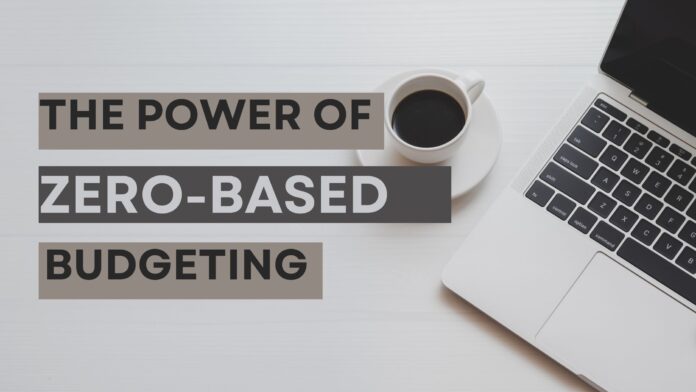Introduction to Zero-Based Budgeting
Budgeting is a crucial aspect of personal and professional financial management. It provides structure, control, and clarity to your income and expenses, allowing you to make more informed decisions about how to allocate your resources. One method of budgeting that has gained popularity in recent years is zero-based budgeting.
Zero-based budgeting (ZBB) is a type of budgeting where all expenses must be justified for each new period, regardless of whether or not they were included in the previous period’s budget. Essentially, this means that expenses start at zero and must be justified based on current needs and priorities.
The goal of ZBB is to optimize spending by identifying areas where costs can be reduced or eliminated altogether. While traditional budgeting typically starts with last year’s numbers as a baseline for the current year’s budget, ZBB requires a fresh start each time a new period begins.
This approach can lead to more accurate cost assessments since it forces decision-makers to rethink their assumptions about what is truly necessary versus what is simply nice to have. Additionally, ZBB can help ensure that every dollar spent has a clear purpose and aligns with overall financial goals.
The History of Zero-Based Budgeting
Zero-based budgeting (ZBB) is a method of budgeting that has been around for decades. Developed by Peter Pyhrr in the 1970s, ZBB was initially used by large corporations such as Texas Instruments and ExxonMobil. The method gained popularity in the late 1970s when President Jimmy Carter adopted it for use in the United States federal government budget.
Pyhrr developed ZBB as a response to traditional budgeting, which he believed was flawed because it simply carried over expenses from previous years without considering whether those expenses were still necessary or if they could be reduced or eliminated. Pyhrr believed that starting each budget cycle with a blank slate would force managers to evaluate every expense and justify its inclusion in the new budget.
This approach, he argued, would lead to more efficient use of resources and cost savings. Although ZBB was initially popular, it fell out of favor in the 1980s as companies found it time-consuming and difficult to implement.
However, interest in ZBB has seen a resurgence recently, particularly among startups and small businesses looking for ways to streamline their budgets and reduce costs. In addition, some government agencies have continued to use ZBB successfully over the years.
Overall, while Zero-Based Budgeting may not be a new concept, its history demonstrates its effectiveness in reducing costs and maximizing efficiency when implemented properly. Its resurgence shows that this method remains relevant today for businesses looking for more effective ways of controlling their expenses while increasing their financial stability through savings opportunities.

The Benefits of Zero-Based Budgeting
Zero-based budgeting (ZBB) is an effective budgeting technique that can help businesses and individuals in managing their finances. The technique involves starting from scratch when creating a budget, meaning all expenses must be justified rather than simply adjusting the previous year’s budget. This approach offers several benefits to its users.
Firstly, ZBB helps with cost savings. It provides a comprehensive view of all expenses incurred by an individual or business unit and identifies areas where they can reduce costs.
By scrutinizing every expense line item, one can identify activities that are not adding value to the overall goal and eliminate them. This process ensures that only essential items are included in the budget and helps to avoid unnecessary expenses.
Secondly, ZBB enhances transparency in budgeting. Unlike traditional budgeting techniques that may carry over errors from past budgets and cover up inefficiencies through incremental adjustments, ZBB requires every expense line item to be justified every time a new budget is created.
This level of scrutiny and transparency generates accurate financial statements as it allows for detailed reporting on spending patterns at various levels of operation – departmental or functional level – helping businesses track how well they are allocating resources. In addition to these benefits, zero-based budgeting also forces individuals and businesses to think critically about their goals and how best to achieve them with the available resources.
The process encourages active participation among stakeholders in identifying key performance indicators (KPIs) tailored towards achieving specific objectives within allocated budgets while promoting accountability across board members for financial management decisions made based on agreed-upon goals. Overall, ZBB facilitates better decision-making processes while creating a culture of responsibility toward efficient resource allocation within organizations or households that adopt it as a tool for budgeting their income and expenses effectively.
The Challenges of Zero-Based Budgeting
Zero-based budgeting is an effective way of budgeting, but it also has its own share of challenges. Here are some of the challenges that come with zero-based budgeting. One of the most significant challenges of zero-based budgeting is the time and effort required to implement it.
Zero-based budgeting requires a lot of work upfront, especially in setting up a baseline for all expenses. This involves analyzing every expense item and determining its value, which can be time-consuming and challenging.
Additionally, it’s not a one-time process. You need to repeat this analysis for each budget cycle to ensure accuracy and effectiveness.
Another challenge associated with zero-based budgeting is that it can be difficult to identify priorities among different departments or programs within an organization. With traditional budgeting, departments typically receive last year’s budget plus an incremental increase or decrease depending on performance or market conditions.
However, with zero-based budgeting, every department must start at zero, which can lead to conflicts between departments as they compete for limited resources and funding. This can make it challenging for organizations to allocate funds fairly across different departments while still achieving their overall goals and objectives without unnecessary cuts.
While there are significant benefits to using a zero-based budget system, it’s important to recognize that there are also challenges associated with its implementation and maintenance over time. To overcome these challenges successfully, organizations must remain committed to the process while utilizing best practices such as clear communication between departments about priorities for each fiscal year’s expenses allocation decisions ensuring that all expenses align with organizational goals and objectives while maintaining financial sustainability through sound decision-making processes throughout the fiscal year.

Zero-Based Budgeting vs. Traditional Budgeting
When comparing zero-based budgeting with traditional budgeting, there are a few key differences to keep in mind. Firstly, traditional budgeting usually involves taking the previous year’s budget and making adjustments as necessary. This means that some expenses from last year may be carried over without much scrutiny, even if they are no longer necessary or efficient.
Zero-based budgeting, on the other hand, requires every expense to be justified and evaluated each time a new budget is created. Secondly, while traditional budgeting focuses primarily on limiting expenses to fit within a predetermined income level, zero-based budgeting is more concerned with optimizing the use of available resources.
This means that zero-based budgeting can actually lead to increased savings in certain areas where efficiencies can be found. Another key difference between traditional and zero-based budgets is the level of detail involved.
Traditional budgets tend to focus on a high-level category expense level, such as rent or employee salaries, whereas zero-based budgets involve expenses for all initiatives and projects, creating transparency around exactly where the business’s money is going. Overall, it’s important to recognize that while both approaches have their merits depending on specific financial needs or goals for the organization, by undertaking an in-depth review of all expenses each quarter, Zero-Based Budgeting can help organizations identify opportunities for savings in areas that might not have been reviewed under traditional methods of budget planning.
How to Implement Zero-Based Budgeting: A Step-by-Step Guide
Implementing a zero-based budget may seem overwhelming at first, but it is a relatively simple process that can be broken down into several steps. The first step is to determine your income by calculating all sources of money coming in each month. This can include not only your primary job salary but also any side hustles or passive income streams you may have.
Once you have determined your total monthly income, the next step is to track your expenses for a month. This will help you understand where your money is going and identify areas where you could potentially reduce spending.
The next step in implementing a zero-based budget is to categorize your expenses into fixed and variable costs. Fixed costs are those that remain the same each month, such as rent or car payments, while variable costs fluctuate from month to month, such as groceries or entertainment expenses.
From there, you can begin assigning every dollar of income a specific expense category until all of your money has been allocated. It’s important to remember that every dollar should be accounted for in some way, whether it’s put towards expenses or savings goals.
After creating your initial budget plan, it’s important to track your spending throughout the month and adjust as needed. You may discover that certain categories need more funding than initially allocated or find areas where you overspent and need to cut back in the following months.
It’s also recommended that you review and adjust your budget on a regular basis to ensure it aligns with any changes in income or financial goals over time. By following these steps for implementing a zero-based budgeting approach, individuals can take control of their finances by thoughtfully allocating expenses and prioritizing savings toward long-term financial goals.

The Envelope Budgeting System: An Overview
The envelope budgeting system is a popular method of budgeting that can be used in conjunction with zero-based budgeting. It involves dividing your expenses into categories and allocating a set amount of cash for each category. You then place the cash for each category into separate envelopes to physically represent the money you have allocated for that category.
This system helps individuals keep track of their spending, avoid overspending, and ensure that they are sticking to their budget. To start using the envelope budgeting system, first, determine your monthly income and expenses.
Then, divide your expenses into categories such as groceries, transportation, housing, entertainment, and so forth. Determine how much money you want to allocate to each category based on your zero-based budget plan.
Once you have determined the amounts for each category, withdraw cash from your bank account and place the allocated amount into an envelope designated for that specific expense. Using physical envelopes to represent your spending limits for each expense category in your zero-based budget plan allows you to be more conscious of how much money is being spent on what expense because once an envelope is empty, there are no more funds allocated for that specific expense until next month’s allocation.
Additionally, this method also provides a visual cue about how much money has been spent or is available within any particular category at any given time. Overall it makes and is easy to stay on top of where your money goes every month when trying out zero-based budgeting.
How to Use the Envelope Budgeting System with Zero-Based Budgeting
Using the Envelope Budgeting System with Zero-Based Budgeting can be a powerful tool to help you stay on track with your finances. The envelope budgeting system is a simple and effective way to manage your money by allocating cash into envelopes for different expense categories.
It works well with Zero-Based Budgeting since every dollar you earn has a specific purpose, which can be easily tracked through this method. To get started, determine which categories you will use for your envelopes.
These categories may include groceries, entertainment, transportation, clothing, and any other expenses that are important to you. Determine how much money you will need for each category by looking at your previous spending habits and setting goals for savings.
You can divide the money accordingly among the envelopes. Once you have filled each envelope with the correct amount of cash, make sure that you only spend what is in each envelope for its specific category.
For instance, if you run out of grocery money in your designated envelope before the end of the month, then resist dipping into another category’s funds to buy groceries. This way of managing expenses may take some time to get used to, but it keeps spending under control while helping cultivate good spending habits and financial discipline.
Using an envelope budgeting system with zero-based budgeting requires discipline and consistency but helps prevent overspending or wasting money on things that aren’t important. It forces one to live within their means while keeping an eye on their overall financial goals, such as saving towards retirement or saving up for an upcoming vacation trip.

Tips to Stick to a Zero-Based Budget
1. Be Realistic with Your Budget: When creating your zero-based budget, it is important to be realistic with your expenses and income.
Be honest about what you can actually afford and set achievable goals for yourself. This will help you avoid the temptation of overspending or under-saving, which can quickly derail your budgeting efforts.
2. Track Your Spending: One of the most effective ways to stick to a zero-based budget is to track your spending regularly.
This means keeping a record of every penny spent and categorizing it accordingly. By doing this, you will be able to identify areas where you may be overspending or where there is room for improvement in terms of saving.
3. Prioritize Your Expenses: Another important tip for sticking to a zero-based budget is prioritizing your expenses.
This means identifying the most essential expenses (such as rent/mortgage, utilities, food) and allocating funds accordingly before moving on to discretionary spending categories like entertainment or hobbies.
4. Use Cash Envelopes: The envelope system can also be an effective tool for sticking to a zero-based budget.
By using cash envelopes labeled with specific spending categories (such as groceries, entertainment, etc.), you can limit yourself to only spending what’s in each envelope each month.
5. Find Ways To Cut Costs: Finding ways to cut costs is crucial if you want to stick to a zero-based budget over time.
Consider things like reducing utility bills by conserving energy, cooking meals at home instead of eating out frequently, or shopping around for better deals on monthly bills such as cable or phone services. By following these tips and staying committed over time, anyone can successfully stick to a zero-based budget and achieve their financial goals!
Conclusion: Making Zero-Based Budgeting Work for You
Zero-based budgeting is a powerful tool that can help you better understand your finances and make meaningful progress toward your financial goals.
By starting from scratch each month, you’re able to take a fresh look at your expenses and make decisions that are truly in alignment with your priorities. However, in order for zero-based budgeting to work for you, it’s important to follow a few key tips.
First and foremost, be sure to regularly track your income and expenses. This will help you stay on top of any changes in your financial situation and adjust your budget as necessary.
Additionally, consider setting aside some savings each month as part of your zero-based budget. Even small amounts can add up over time and give you more flexibility when unexpected expenses arise.
When it comes to sticking to a zero-based budget, accountability is key. Consider finding an accountability partner or joining an online community dedicated to personal finance.
These resources can offer support and encouragement when you’re struggling with temptation or feeling overwhelmed. Ultimately, the most important thing is to find a system that works for you.
Whether it’s using envelopes or tracking expenses online, the key is consistency and commitment to the process of managing your money wisely. With zero-based budgeting as part of your financial toolkit, you’ll be well on your way toward achieving greater financial stability and freedom over time.
Ready to take the plunge into the world of finance and budgeting? Diving deeper, discover What is the 50/30/20 rule for budgeting, an innovative strategy to streamline your income allocation and make saving second nature. If you’re also curious about other foundational strategies, our piece on traditional budgeting offers a comprehensive look into this time-tested approach, helping you decide which budgeting methodology fits you best. Don’t miss out!










